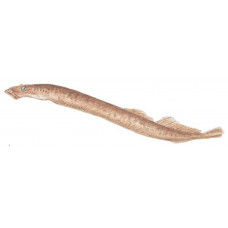Latin name
Petromyzon marinus
Other names
Lamprey eel, stone sucker, nannie nine eyes (U.K.); Danish: havlampret; Dutch: zeeprik; Finnish: merinahkiainen; French: lamproie marine; Italian: lamprea di mar; Norwegian: havnioye; Portuguese: lampreia do mar; Russian: morskaja minoja; Spanish: lamprea de mar.
Identification
Fish without jaws are fish-like vertebrates, eel-like in shape, with a cartilaginous or fibrous skeleton in which there are no bones. They have no paired limbs and no developed jaws or bony teeth. Their skin is extremely slimy and lacks scales. Fossils of lampreys date back 280 million years. The jawless, eel-like lampreys are as ugly in shape and diet as their hagfish cousins, but they differ in other ways. Hagfish are strictly marine fish, while lampreys are either entirely freshwater or, if they live in the sea, return to freshwater streams to spawn. Lampreys have a large sucking disc instead of a mouth and a well-developed olfactory system. The mouth is filled with horny, sharp teeth that surround a tongue-like file. The body has smooth skin without scales. They have two dorsal fins, no lateral line, no vertebrae, no swim bladder, and no paired fins. Lampreys have no protruding antennae on the snout, their eyes are well developed in adults and visible from the outside, there are seven external gill openings on each side, and the nasal opening is located in the upper part of the head. Lampreys are usually parasitic. The lamprey uses its sucking mouth to attach itself to the side of a live fish, then uses its horny teeth to bite through the skin and scales of the victim, sucking out blood and body juices. Young lampreys, when in salt water or on their way to salt water, are white underneath and blackish-blue, silver, or leaden above. Large specimens approaching maturity are usually mottled brown or various shades of yellow-brown and various shades of green, red, or blue. Sometimes they appear black when the dark spots blend together. The belly may be white, grayish, or a lighter shade of the main color of the back. Coloration increases during the breeding season.
Distribution
Sea lampreys range across the western Atlantic from southern Greenland, Labrador, and the Gulf of St. Lawrence south to the Gulf of Mexico in Florida. The fish is land-locked in the Great Lakes region, Finger Lakes, Oneida Lake and Champlain Lake. In Russia, it lives in the Baltic Sea from where it enters the Narva, Western Dvina, Neman and other rivers. It breeds exclusively in freshwater.
Habitat
Passerine fish. In North America in the Great Lakes forms a living form.
Size
Adult sea lampreys range in length from 2 to 21/2 feet. The maximum recorded length is nearly 4 feet and the maximum weight is 5.4 pounds. The incubation period of the eggs is about 2 weeks. Blind, toothless larvae emerge from the eggs and live in soft bottom sediments for 3 to 14 years before metamorphosing into adult lampreys.
Life history and Behavior
Lampreys spawn in the spring. They ascend streams where the bottom is rocky or gravelly and build shallow depressions by moving rocks with their sucking mouths. The male and female usually work together to build the nest. When the pair is ready to spawn, they mix the sand with vigorous body movements, as milk and caviar are deposited at the same time. The eggs stick to the sand particles and sink to the bottom of the nest. The pair then separates and builds another nest directly above the first, stirring up more sand and pebbles that flow downstream and cover the eggs. This process is repeated at short intervals until spawning is complete. The adults then die. After a few days, the young emerge and drift downstream until they are deposited in a quiet stretch of water, where they settle and burrow into the bottom to spend several years as larvae (called ammocets). When they reach several inches in length (depending on the species), the ammocetes transform in late summer or fall into adult lampreys, equipped with sucking discs and round rows of horny teeth.
Food and feeding habits
Larvae feed on detritus. Adults are parasitic, sucking the blood of herring, cod, salmon, sharks, sturgeon and other fish.
Reproduction
A passage form. Spawns in the spring at a temperature of at least 10°C in sandy bottoms, laying eggs in shallow holes dug by the female. During reproduction, sea lampreys stay in small groups. After spawning, the adults go out to sea and stay close to the shore. The fecundity is up to 200,000 eggs or more.
| Classification | |
| Phylum | Chordata |
| Class | Hyperoartia |
| Squad | Petromyzontiformes |
| Family | Petromyzontidae |
| Genus | Petromyzon |
| Species | P. marinus |
| Features | |
| Conservation status | Least Concern |
| Habitat | Pelagic |
| Life span, years | 14 |
| Maximum body weight, kg | 2.3 |
| Maximum length, cm | 120 |
| Sailing speed, m/s | No information |
| Threat to people | Edible |
| Way of eating | Predator |
Lamprey: Sea Lamprey
Tags: Lamprey: Sea Lamprey




